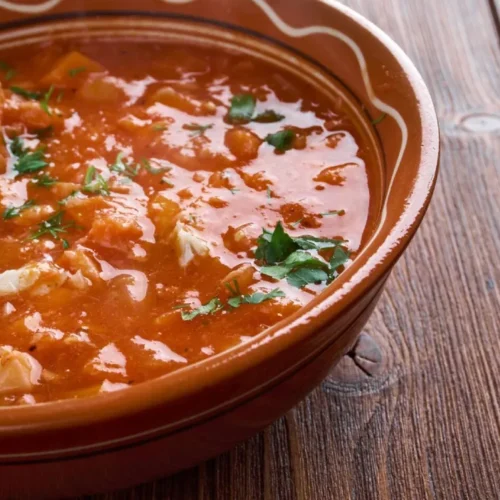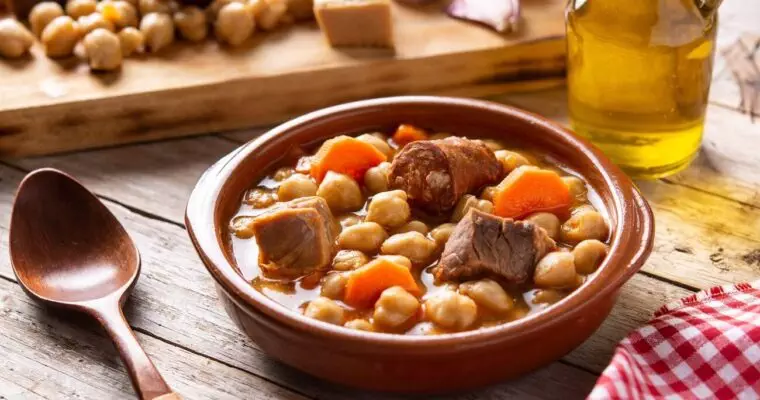Ajoarriero is more than just a dish, it’s a reflection of Spain’s rich culinary history. With roots in the life of muleteers, who prepared it as they traveled the northern regions of Spain, this flavorful cod stew has evolved into a staple of Spanish gastronomy. In this guide, we’ll explore everything from its historical background to expert tips for perfecting the recipe, along with frequently asked questions and other Spanish dishes you’ll love.
Table of Contents
Ajoarriero: A Flavorful Spanish Dish with History
The name ajoarriero comes from the word arrieros (muleteers), who were known for transporting goods across Spain’s rugged terrain. These hardworking individuals needed a meal that was both filling and made with ingredients that could withstand long journeys. Thus, ajoarriero was born—a simple yet hearty dish based on preserved ingredients like salted cod, potatoes, and peppers. Although the dish is most commonly associated with Navarra and the Basque Country, variations of ajoarriero can be found across many regions in northern Spain.
Interestingly, in Cuenca, a different dish known as atascaburras shares the name ajoarriero. It’s also made with cod but takes on a more mashed texture, demonstrating the culinary diversity that exists within Spain’s regional cuisine.
Essential Ingredients for an Authentic Ajoarriero
Ajoarriero’s beauty lies in its simplicity, but the key to a successful dish is high-quality ingredients. Here’s what you’ll need for the traditional recipe:
- Desalted cod: You can either buy pre-desalted cod or soak salted cod in water for 24–48 hours, changing the water regularly. Fresh cod also works, though it lacks the characteristic saltiness.
- Peppers: Traditionally, roasted red peppers are used, but fresh red or green peppers can be substituted. Piquillo peppers from a jar or can are a fantastic alternative for added depth.
- Potatoes (optional but recommended): These can be fried separately or simmered in the stew to help thicken the sauce.
- Garlic and onions: Essential aromatics that form the base of the dish.
- Olive oil: A good-quality olive oil is critical for flavor.
- Tomatoes: Use fresh tomatoes or high-quality canned tomatoes to build a rich sauce.
- Paprika: Adds warmth and depth to the dish. Sweet or smoked paprika are popular options.
Step-by-Step Guide to Cook Ajoarriero
This traditional recipe requires patience, but the reward is a flavorful and comforting stew. Here’s how to make an authentic ajoarriero:
- Prepare the cod: If you’re using salted cod, make sure it’s properly desalted beforehand. Fresh cod fillets can also be used if that’s your preference.
- Sauté the base: In a large pot, heat a generous amount of olive oil and sauté finely chopped onions and garlic until golden. Add chopped peppers and continue cooking until softened.
- Add tomatoes: Stir in the tomatoes, either fresh or canned, and cook until they break down and form a rich sauce.
- Incorporate potatoes: If using potatoes, peel and chop them into bite-sized pieces, then add them to the pot. Let them simmer in the sauce until tender, which will also help thicken the stew.
- Cook the cod: Once the potatoes are almost done, add the cod fillets or pieces. Simmer gently, making sure not to overcook the fish—it should be tender and flaky.
- Optional step pil-pil technique: For added flavor and texture, use the cod skins to make a pil-pil sauce by simmering them in oil and emulsifying the oil with the natural gelatin from the skin. If you’re feeling adventurous, this can add a luxurious touch to your stew.
- Adjust the seasoning: Season with paprika, salt, and pepper. Remember that salted cod may already contribute enough salt, so taste before adding extra.
Pro Tips for Personalizing Your Ajoarriero
Here are some extra tips to elevate your ajoarriero:
- Balance the consistency: The final dish should be moist, but not soupy. If it’s too runny, let it simmer uncovered to reduce the liquid. If it’s too dry, add a bit of stock or water.
- Don’t skip the olive oil: This dish thrives on good olive oil. If you can, use extra-virgin olive oil for the best results.
- Experiment with peppers: Piquillo peppers add a smoky sweetness to the dish, but feel free to use a mix of fresh and roasted peppers for a more complex flavor.
Regional Variations of Ajoarriero in Spain
As with many traditional Spanish dishes, ajoarriero varies across regions. The dish is typically a thick stew with cod and peppers in Navarra and the Basque Country. However, in Cuenca, it’s a heartier, mashed version with potatoes and eggs known as atascaburras. Across Northern Spain, you’ll find subtle differences in seasoning, the type of cod used, and even the cooking techniques.
Perfect Pairings: What to Serve with Ajoarriero
Ajoarriero is a versatile dish that can be enjoyed on its own or with a variety of sides:
- Crusty bread: Essential for soaking up the flavorful sauce.
- Simple green salad: The freshness of a salad with vinaigrette provides a nice contrast to the rich, hearty stew.
- Spanish wine: A crisp white wine like Albariño or a light red such as a Rioja pairs beautifully with the dish.
FAQs About Ajoarriero
What type of cod should I use: fresh or salted?
- Traditionally, salted cod is used, but fresh cod is a suitable substitute if it’s more readily available.
Can I prepare ajoarriero in advance?
- Yes! In fact, like many stews, ajoarriero often tastes better the next day as the flavors have time to meld.
How do I thicken the sauce if it’s too watery?
- You can reduce the sauce by simmering it uncovered, or add potatoes to help thicken it with their natural starches.
What are some common mistakes to avoid?
- Overcooking the cod can make it tough. Be sure to add the fish towards the end of cooking and simmer gently until just cooked through.
Related Spanish Recipes You’ll Love
If you enjoy cooking Spanish dishes, here are a few related recipes to try:
- Bacalao a la Vizcaína: Another traditional cod recipe from the Basque Country, with rich red pepper and tomato sauce.
- Marmitako: A Basque tuna stew with potatoes, peppers, and tomatoes.
- Pisto: Spain’s answer to ratatouille, a vegetable medley simmered with olive oil and garlic.
- Caldereta: A traditional fish or meat stew, perfect for those who love hearty one-pot meals.
Conclusion
Ajoarriero is much more than just a traditional Spanish dish—it’s a testament to the ingenuity of past generations who crafted nourishing meals with simple, preserved ingredients. By mastering the art of preparing this cod-based stew, you not only connect with a rich culinary history but also bring the comforting flavors of Spain’s northern regions into your home. Whether you follow the recipe to the letter or make your adaptations, the key is in the balance of flavors and textures, with each component contributing to a hearty, satisfying meal. With these tips and tricks in hand, you’re ready to impress your guests with an authentic, flavorful ajoarriero that reflects Spain’s rich gastronomic heritage.

Authentic Ajoarriero Recipe: 3 Powerful Tips to Perfect it
Ingredients
- 500g (1 lb) desalted cod (or fresh cod fillets)
- 1 large onion, finely chopped
- 4 cloves garlic, minced
- 2 red bell peppers, roasted and peeled (or fresh, sliced)
- 1 green bell pepper, sliced
- 4 medium tomatoes, peeled and chopped (or 1 can of diced tomatoes)
- 3 medium potatoes, peeled and diced (optional)
- 100ml (½ cup) olive oil
- 1 teaspoon sweet or smoked paprika
- Salt and pepper, to taste
- Optional: Skins from the cod to make a pil pil sauce
Instructions
- Prepare the cod:If using salted cod, soak it in water for 24–48 hours, changing the water every 8 hours to remove excess salt. Drain and pat dry before cooking.If using fresh cod, simply pat dry and cut into portions.
- Roast the peppers (if using fresh):Roast the red peppers over an open flame or in the oven until their skins blacken. Place them in a covered bowl for 10 minutes, then peel and remove the seeds. Cut into strips and set aside.
- Cook the aromatics:In a large pot, heat the olive oil over medium heat. Add the chopped onion and cook for about 5–7 minutes until softened and golden.Add the minced garlic and stir for 1 minute, until fragrant.
- Add the peppers and tomatoes:Stir in the roasted red pepper strips, fresh green pepper slices, and tomatoes. Let the mixture cook for about 10 minutes until the vegetables soften, and the tomatoes break down into a sauce.
- Optional: Cook the potatoes:If you're using potatoes, add them to the pot now. Pour in a little water or stock to cover the potatoes, and let them simmer in the sauce for about 20 minutes until tender.
- Add the cod:Once the potatoes are nearly done (or if skipping the potato step), add the cod fillets into the pot. Gently simmer for 10-15 minutes, ensuring the cod stays tender and flakes easily.
- Optional: Prepare the pil pil sauce:If you want to make the dish richer, use the cod skins. In a separate pan, cook the skins in olive oil over low heat, stirring to emulsify the oil with the gelatin from the skins. Drizzle this pil pil sauce over the final dish for extra flavor.
- Season and finish:Add the paprika and stir gently, making sure it blends into the sauce. Taste and adjust seasoning with salt and pepper, keeping in mind the saltiness of the cod.
- Serve:Serve the ajoarriero hot, ideally with crusty bread on the side to soak up the rich sauce. The consistency should be thick, not too soupy, but you can adjust by simmering longer or adding a splash of water.








